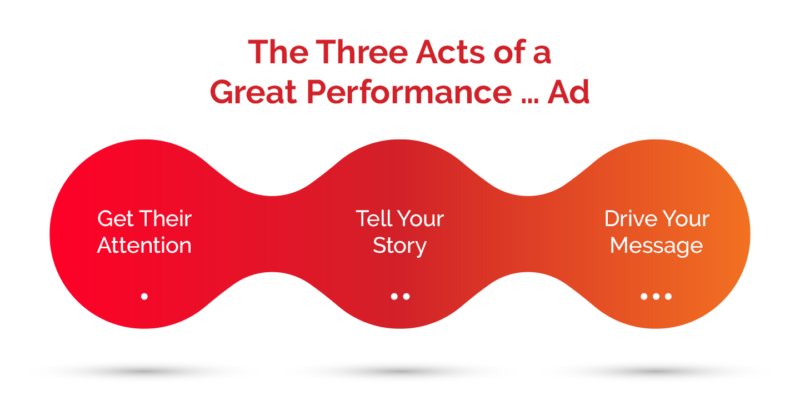In 1979, Syd Field wrote a book called, “Screenplay: The Foundation of Screenwriting.” To this day, it is still the go-to manual for aspiring screenwriters looking to write the next Oscar-winning film. In his lifetime, Field read thousands of screenplays and, through that experience, determined that the most successful ones followed what he coined a “three-act structure.” It was groundbreaking work.
The three acts broke down in this way: Act I – Set-up, Act II – Confrontation, Act III – Resolution. It’s that simple. If you want to tell a compelling story, just follow the structure that has been proven to work — and be interesting while you do it.
Whether it’s a static digital ad or a 30-minute long-form brand narrative, you’re always telling a story.
We believe that the same three-act structure works in advertising as well, especially performance advertising. What are advertisers if not storytellers after all? Whether it’s a static digital ad or a 30-minute long-form brand narrative, we’re always telling a story. And that story needs structure. So, let’s talk about the three steps that we use to guide all of our creative.
Step 1: Get Their Attention
This is essentially your intro; you have to grab their attention. Field explains how to visually “grab” the reader from page one, word one, and you need to do the same thing. A screenwriter uses Act 1 to set up the story; as an advertiser, you’ll use this step to make sure the user recognizes that you have a story to tell. In today’s world of scrolling and ad skipping, you have to continue to find ways to be thumb-stopping and to avoid the dreaded skip button. How you grab their attention can vary greatly. You can use imagery, color choices, action, copy, or a combination of these. Your choice should consider the medium in which your ad will be presented. Is there audio? If so, will it auto-play? Is it a video or static unit? Unlike with a screenplay, advertisers usually only have one second for this step. But it’s just as important, because your story will never have a chance to be told if you don’t accomplish it successfully.
Step 2: Tell Your Story
In Act 2 of a screenplay, you’re bringing in conflict and exploring the protagonist’s main dilemma. It’s the core of the story and, according to Field, should take up about half the film’s running-time. In an ad, you’re providing your entire story in Step 2. Adding to the challenge, you might only have 20 seconds to tell the story, or five words. Use your time and/or space wisely and connect with your audience. The way you do that is by ensuring you hone in on the exact story you want to tell. All too often, brands have too many points to make and end up making none. Make sure you have a strong strategic foundation. Outline your goals, value statement and voice, and make sure your creative matches those strategic elements. Whatever your story, remember that clarity is key. Your story needs to be understandable and memorable.
Step 3: Drive Your Message
Like a screenplay’s Act 3 resolution, this is where you wrap things up. The best way to nail the resolution is to clearly outline the action you want from the consumer and then drive your message home with a clear call to action. If you’re simply focused on branding, maybe you leave them with your tagline. But if you want to prompt an action, then you need to be clear: What do you want them to do? View, click, watch, buy now, call, visit? Make it clear, and make it easy.
Syd Field said his book was “not a ‘how-to’ book.” He couldn’t teach anyone to come up with a great story, but he could “show them what they have to do to write a successful screenplay.” Consider this post similarly. As a creative agency we can come up with great ideas, but that’s not something we can explain in a blog post. We can, however, outline the keys to executing that great idea in a way to make the biggest impact.
If you want to be confident your ad is going to perform, make sure you review it through the prism of the three-act ad structure. Does it grab attention? Are you telling a clear story? Did you deliver a clear call to action?
Do that on every ad unit, whether it’s a static digital unit, a text link, or a long-form video, and your results are sure to improve.


